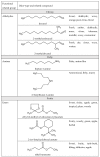Is It Possible to Predict the Odor of a Molecule on the Basis of its Structure?
- PMID: 31226833
- PMCID: PMC6627536
- DOI: 10.3390/ijms20123018
Is It Possible to Predict the Odor of a Molecule on the Basis of its Structure?
Abstract
The olfactory sense is the dominant sensory perception for many animals. When Richard Axel and Linda B. Buck received the Nobel Prize in 2004 for discovering the G protein-coupled receptors' role in olfactory cells, they highlighted the importance of olfaction to the scientific community. Several theories have tried to explain how cells are able to distinguish such a wide variety of odorant molecules in a complex context in which enantiomers can result in completely different perceptions and structurally different molecules. Moreover, sex, age, cultural origin, and individual differences contribute to odor perception variations that complicate the picture. In this article, recent advances in olfaction theory are presented, and future trends in human olfaction such as structure-based odor prediction and artificial sniffing are discussed at the frontiers of chemistry, physiology, neurobiology, and machine learning.
Keywords: flavor; odor; odorant; olfaction; olfactory sense; sensory perception; structure-function relationship; volatile organic compounds.
Conflict of interest statement
The authors declare no conflict of interests.
Figures








References
-
- Depelteau J.S., Brenzinger S., Briegel A. Reference Module in Life Sciences. Elsevier; Amsterdam, The Netherlands: 2019. Bacterial and Archaeal Cell Structure.
-
- Choi N.-E., Han J.H. How Flavor Works—The Science of Taste and Aroma. John Wiley & Sons, Ltd.; Chichester, UK: 2015.
-
- Padodara R.J., Jacob N. Olfactory Sense in Different Animals. Indian J. Vet. Sci. 2014;2:1–14.
Publication types
MeSH terms
Substances
Grants and funding
LinkOut - more resources
Full Text Sources
Other Literature Sources

